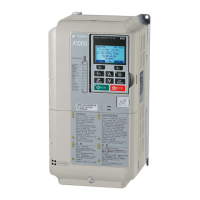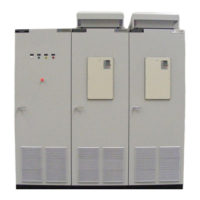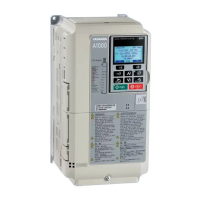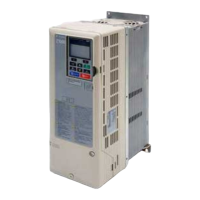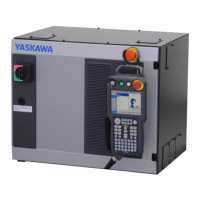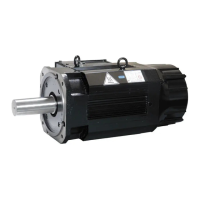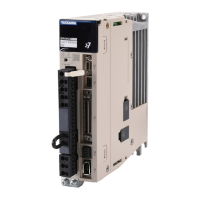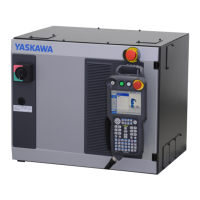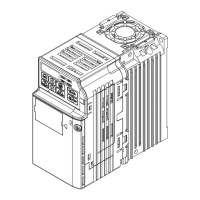A.4 Drive Specifications
Note: 1. Perform rotational Auto-Tuning to obtain the performance specifications given below.
2. For optimum performance life of the drive, install the drive in an environment that meets the required specifications.
Item Specification
Control
Characteristics
Control Method
The following control methods can be set using drive parameters:
• V/f Control (V/f)
• V/f Control with PG (V/f w/PG)
• Open Loop Vector Control (OLV)
• Closed Loop Vector Control (CLV)
• Open Loop Vector Control for PM (OLV/PM)
• Advanced Open Loop Vector Control for PM (AOLV/PM)
• Closed Loop Vector Control for PM (CLV/PM)
Frequency Control Range
0.01 to 400 Hz
Frequency Accuracy
(Temperature Fluctuation)
Digital input: within ±0.01% of the max output frequency (-10 to +40°C)
Analog input: within ±0.1% of the max output frequency (25°C ±10°C)
Frequency Setting Resolution
Digital inputs: 0.01 Hz
Analog inputs: 1/2048 of the maximum output frequency setting (11 bit plus sign)
Output Frequency Resolution
0.001 Hz
Frequency Setting Signal
-10 to 10 V, 0 to 10 V, 0 to 20 mA, 4 to 20 mA, Pulse Train Input
Starting Torque <1>
V/f, V/f w/PG: 150% at 3 Hz
OLV: 200% at 0.3 Hz
CLV, AOLV/PM, CLV/PM: 200% at 0 r/min
OLV/PM: 100% at 5% speed
Speed Control Range <1>
V/f, V/f w/PG: 1:40
OLV: 1:200
CLV, CLV/PM: 1:1500
OLV/PM: 1:20
AOLV/PM: 1:100
Speed Control Accuracy <1>
OLV: ±0.2% (25°C ±10°C), CLV: ±0.02% (25°C ±10°C)
Speed Response <1>
OLV, OLV/PM, AOLV/PM: 10 Hz
CLV, CLV/PM: 50 Hz
Torque Limit
Parameters setting allow separate limits in four quadrants (available in OLV, CLV, AOLV/PM, CLV/PM)
Accel/Decel Time
0.0 to 6000.0 s (4 selectable combinations of independent acceleration and deceleration settings)
Braking Torque
Approx. 20% (approx. 125% when using braking resistor)
<2>
c Short-time decel torque <3>: over 100% for 0.4/ 0.75 kW motors, over 50% for 1.5 kW motors, and over 20% for 2.2 kW and
above motors
<4> (over excitation braking/High Slip Braking: approx. 40%)
d Continuous regenerative torque: approx. 20%
<4> (approx. 125% with dynamic braking resistor option <2>: 10% ED, 10s)
Braking Transistor
Models 2A0004 to 2A0138, 4A0002 to 4A0072 have a built-in braking transistor.
V/f Characteristics
User-selected programs and V/f preset patterns possible
Main Control Functions
Torque Control, Droop Control, Speed/torque Control Switching, Feed Forward Control, Zero Servo Function, Momentary
Power Loss Ride-Thru, Speed Search, Overtorque/Undertorque Detection, Torque Limit, 17 Step Speed (max), Accel/decel
Switch, S-curve Accel/decel, 3-wire Sequence, Auto-tuning (rotational, stationary tuning), Dwell, Cooling Fan on/off Switch,
Slip Compensation, Torque Compensation, Frequency Jump, Upper/lower Limits for Frequency Reference, DC Injection
Braking at Start and Stop, Overexcitation Braking, High Slip Braking, PID Control (with sleep function), Energy Saving Control,
MEMOBUS/Modbus Comm. (RS-422/485 max, 115.2 kbps), Fault Restart, Application Presets, DriveWorksEZ (customized
function), Removable Terminal Block with Parameter Backup Function, Online Tuning, KEB, Overexcitation Deceleration,
Inertia (ASR) Tuning, Overvoltage Suppression, High Frequency Injection, etc.
Protection
Functions
Motor Protection Electronic thermal overload relay
Momentary Overcurrent Protection
Drive stops when output current exceeds 200% of Heavy Duty Rating
Overload Protection
Drive stops after 60 s at 150% of rated Heavy Duty output current
<5>
Overvoltage Protection
200 V class: Stops when DC bus voltage exceeds approx. 410 V
400 V class: Stops when DC bus voltage exceeds approx. 820 V
Undervoltage Protection
200 V class: Stops when DC bus voltage falls below approx. 190 V
400 V class: Stops when DC bus voltage falls below approx. 380 V
Momentary Power Loss Ride-Thru
Immediately stop after 15 ms or longer power loss.
<6> Continuous operation during power loss than 2 s (standard) <7>
Heatsink Overheat Protection Thermistor
Braking Resistor Overheat Protection
Overheat input signal for braking resistor (Optional ERF-type, 3% ED)
Stall Prevention Stall Prevention is available during acceleration, deceleration, and during run.
Ground Protection Electronic circuit protection <8>
DC Bus Charge LED Remains lit until DC bus voltage falls below 50 V
Environment
Area of Use Indoors
Ambient Temperature
-10 to 40°C (NEMA Type 1 enclosure),
-
10 to 50°C (IP00 enclosure), up to 60°C with output current derating
Humidity 95 RH% or less (no condensation)
Storage Temperature
-20 to 60°C (short-term temperature during transportation)
Altitude Up to 1000 meters without derating, up to 3000m with output current and voltage derating
Vibration / Shock
10 to 20 Hz: 9.8 m/s
2
20 to 55 Hz: 5.9 m/s
2
(2A0004 to 2A0211, 4A0002 to 4A0165)
2.0 m/s
2
(2A0250 to 2A0415, 4A0208 to 4A0675)
Safety Standard
Two Safe Disable inputs and 1 EDM output according to EN61800-5-1, EN954-1/ISO13849 Cat. 3, IEC/EN61508 SIL2,
Insulation coordination: class 1
Note: Time from input open to drive output stop is less than 1 ms
Protection Design IP00 enclosure, IP20/NEMA Type 1 enclosure <9>
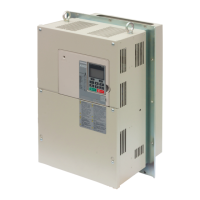
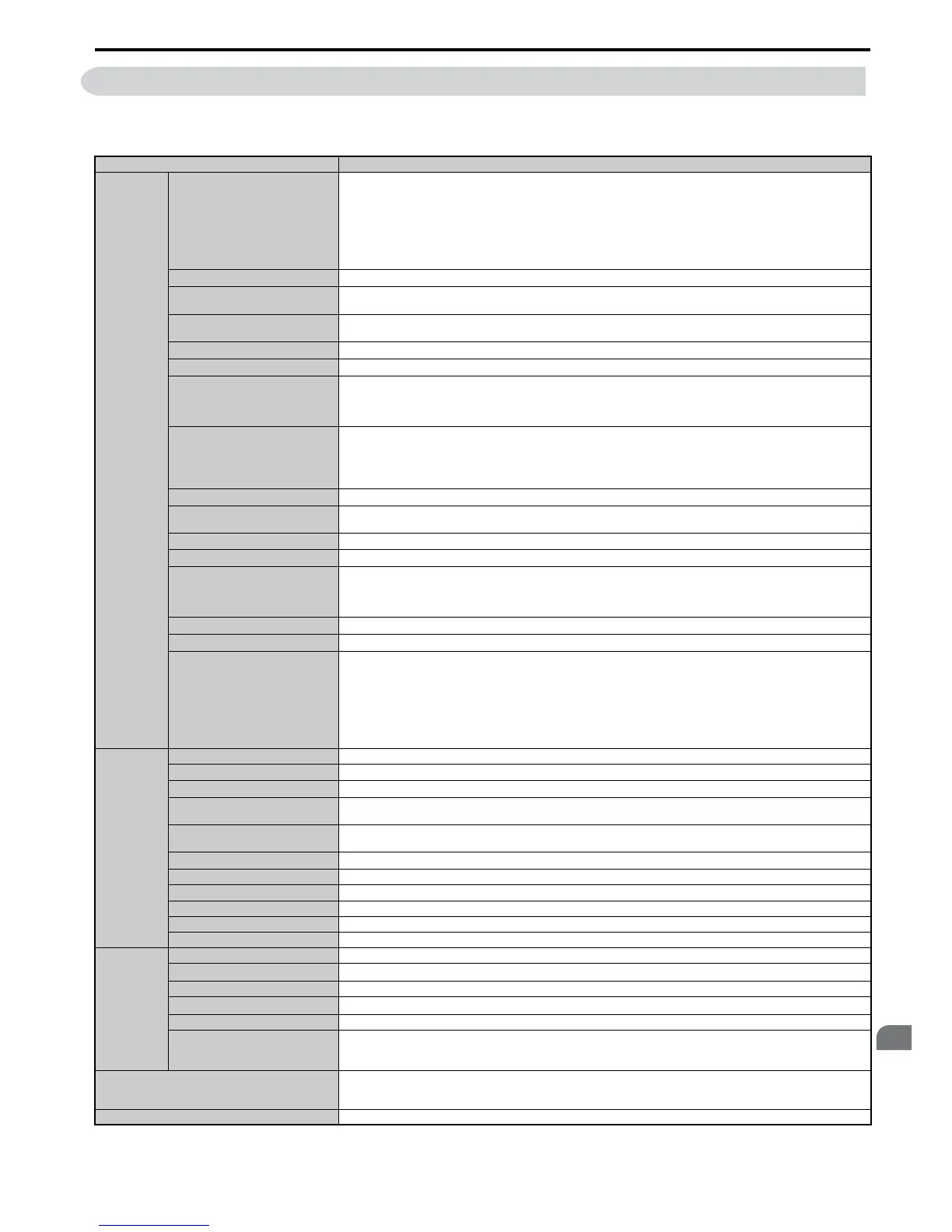